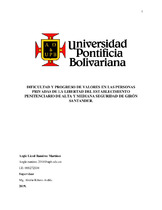| dc.contributor.advisor | Director. Ribero Ardila, Abdón | |
| dc.contributor.author | Ramírez Martínez, Angie Liced | |
| dc.coverage.temporal | 2019 | |
| dc.date.accessioned | 2021-02-05T21:52:10Z | |
| dc.date.available | 2021-02-05T21:52:10Z | |
| dc.date.issued | 2019-07 | |
| dc.identifier.uri | http://hdl.handle.net/20.500.11912/7910 | |
| dc.description | 98p.: (pdf); il; imágenes; gráficas; tablas; anexos. | spa |
| dc.description.abstract | El trabajo que se presenta en este documento contiene el proceso desarrollado en el Establecimiento Penitenciario de Alta y Mediana Seguridad (EPAMS) de Girón, Santander, con una población de 1657 personas privadas de la libertad, quienes participaron de manera voluntaria y firmaron un consentimiento en el que aprobaron el uso académico de sus respuestas. El debido proceso que se realizó con estos participantes fue la aplicación individual de la escala de valores VQ que consta de dos subescalas: obstrucción, que se define como la dificultad para encaminarse a valores, que consta de 5 ítem (1, 2, 6, 8, 10); y progreso, que es el avance para encaminar a valores (3, 4, 5, 7, 9). Todo ello nace del interés de saber la dificultad o el progreso de valores que tiene esta población, verificar cuáles son los valores más relevantes para ellos y saber si es válida y certera esta escala en los PPL. A través de este proceso académico se evidenció que por motivos de comprensión es necesario hacer una modificación a la escala para una próxima aplicación. | spa |
| dc.description.abstract | The work presented in this document contains the process developed in the Penitentiary Establishment of High and Medium Security (EPAMS) in Girón, Santander, with a population of 1,657 persons deprived of liberty, who participated voluntarily and signed a consent in which they approved the academic use of their answers. The due process that was carried out with these participants was the individual application of the VQ scale of values that consists of two subscales: obstruction, which is defined as the difficulty to go to values, which consists of 5 items (1, 2, 6, 8, 10); and progress, which is the advance to guide values (3, 4, 5, 7, 9). All this arises from the interest of knowing the difficulty or progress of values that this population has, to verify which are the most relevant values for them and to know if this scale is valid and accurate in the PPL. Through this academic process it was evidenced that for reasons of understanding it is necessary to make a modification to the scale for a next application. | eng |
| dc.format.mimetype | application/pdf | |
| dc.language.iso | spa | |
| dc.publisher | Universidad Pontificia Bolivariana | spa |
| dc.rights | Attribution-NonCommercial-NoDerivatives 4.0 International | * |
| dc.rights.uri | http://creativecommons.org/licenses/by-nc-nd/4.0/ | * |
| dc.subject | Valores | spa |
| dc.subject | Presos | spa |
| dc.subject | Girón (Santander, Colombia) | spa |
| dc.subject | Prisiones - Penitenciario de Alta y Mediana Seguridad (PPAMS) | spa |
| dc.subject | Progreso | spa |
| dc.title | Dificultad y progreso de valores en las personas privadas de la libertad del establecimiento penitenciario de alta y mediana seguridad de Girón Santander | spa |
| dc.type | Servicio Social | spa |
| dc.publisher.department | Escuela de Ciencias Sociales | spa |
| dc.publisher.program | Psicología | spa |
| dc.type.hasVersion | publishedVersion | spa |
| dc.description.sectional | Bucaramanga | spa |
| dc.description.degreename | Psicólogo | spa |


